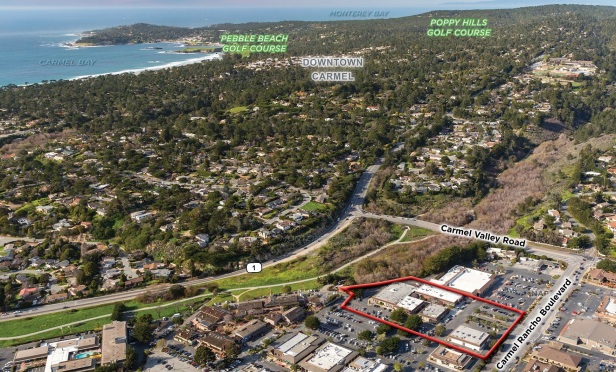 Carmel Rancho II Shopping Center comprises 44,676 square feet of rentable retail space.
Carmel Rancho II Shopping Center comprises 44,676 square feet of rentable retail space.
CARMEL, CA—Grocery-anchored centers remain popular for tenants requiring daily needs exposure, according to a second-quarter retail report by Cushman & Wakefield. A good example of investor and tenant appeal is Carmel Rancho II Shopping Center, a neighborhood shopping center in Monterey County.
This center has been family owned since it was originally built in 1959. The Beeman Family Trust recently sold the property located at 26200 and 26536-26549 Carmel Rancho Blvd. for $13.55 million.
The buyer was a private capital buyer out of San Francisco, which acquired the property as the up-leg in a 1031 Exchange. The buyer sold an apartment building in San Francisco as the down-leg of the exchange and was represented by Paul Radcliffe of Alain Pinel.
Michael Schoeder and Josh Jones with Cushman & Wakefield Monterey and Dan Wald of the firm's retail investment advisors group in San Francisco represented the seller in the transaction.
"Located in the mouth of Carmel at the entrance to the Carmel Valley, the property is an iconic location within the Carmel/Pebble Beach retail submarket, the premier retail submarket on the Monterey Peninsula," says Jones. "Carmel is a world-famous destination, renowned for its picturesque charm, beautiful white sand beach, performing arts and hundreds of upscale shops, art galleries and world-class restaurants."
Carmel Rancho II Shopping Center comprises 44,676 square feet of rentable retail space. The center is shadow-anchored by a Lucky supermarket. In addition, the center is anchored by BevMo and an In-Shape Fitness Center, both of which draw customers from throughout the Carmel and Carmel Valley high-demographic trade areas. The property was 98% leased at the time of sale.
"This is an irreplaceable investment that comes along for sale in the Carmel area once every 25 years," said Schoeder. "This 60-year-old center has delivered to its owners a highly stable and high-quality income stream. In addition to the dependable income stream, the new owner has been presented with an exciting and significant value-add opportunity. Further, due to the almost insurmountable barriers-of-entry to develop new competition, the buyer also has the luxury of implementing a repositioning strategy with little concern related to the potential of competing projects."
Schroeder went on to say that 1031 transactions from all regions of California are on the uptick.
"The purchase price was below replacement cost and the buyer has significant upside potential through repositioning the property to create a more diverse tenant mix and growing rents," Schoeder tells GlobeSt.com. "Recently we have experienced an upswing in 1031 Exchanges, and private capital buyers from the San Francisco Bay Area and other regions throughout California are looking to invest their money on the Monterey Peninsula, where cap rates have historically been 100 to 150 basis points higher than the Bay Area. We currently have several other properties either in contract or available for sale in the Carmel area which have generated a lot of buyer interest. We also have other sellers who are now expressing more interest in wanting to sell at this time, which is creating new market opportunities."
Good quality class-A shopping centers and downtown areas continued to be favorite locations for retailers and shoppers, says the Cushman & Wakefield report. Class-B and some class-C centers are also experiencing leasing activity mainly from local and start-up tenants. Restaurants and service-oriented retailers–such as fitness clubs, boutique gyms, yoga studios, health, education and child day care–remain active.
© Touchpoint Markets, All Rights Reserved. Request academic re-use from www.copyright.com. All other uses, submit a request to [email protected]. For more inforrmation visit Asset & Logo Licensing.







